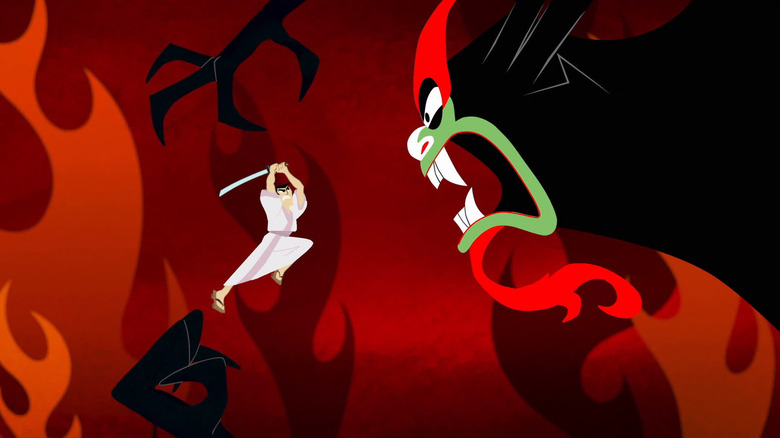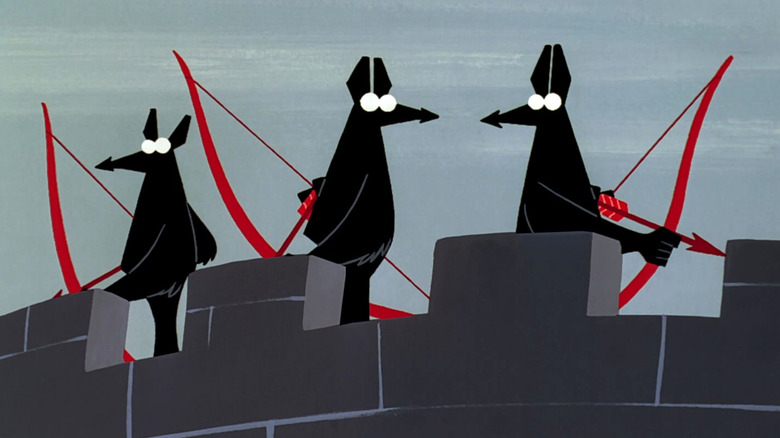A Cartoon Network Classic Was Born Out Of Complaints About Action Shows
In the '90s and early '00s, Cartoon Network was almost an oasis for animation. This was a place where artists could create their own shows and be supported by a studio and a network, rather than cartoons being created by producers or executives. It was a new golden age after the creative bankruptcy of the toy ad-driven '80s, an era of such groundbreaking shows as "The Powerpuff Girls" and "Dexter's Laboratory," of experimental shows and stunning animation.
After the initial wave of cartoons, Cartoon Network Studios was established, and a second generation of shows created by the original animators started being released. Key among them was "Samurai Jack," the highest-rated animated series on Metacritic and a testament to the beauty of animation. The cartoon follows a time-traveling samurai who attempts to stop a powerful shapeshifting demon from taking over the world. The show explored a myriad of genres and tones, tacking demons, robots, and all sorts of weird creatures, enemies, and allies — like Scots and pirates.
Genndy Tartakovsky first came up with some elements of the story for "Samurai Jack" when he was only 10 years old, but when it came time to pitch his follow-up to "Dexter's Laboratory," the impetus came from a disillusionment with what was on TV at the time.
"I had been complaining about action shows since I was a kid," Tartakovsky told IndieWire for the 25th anniversary of Cartoon Network Studios. "Both anime shows and also American shows would have 20 minutes of talking and then two minutes of great action. They didn't give me enough, I wanted more. And I wanted a break from the dialogue of 'Dexter' and 'Powerpuff,' so the driving factor was me wanting something different. And the result was 'Samurai Jack.'"
Samurai Jack was unlike anything else on TV
Tartakovsky isn't wrong. Though there were plenty of shows with action scenes in them before "Samurai Jack," they tended to fragmentate the action and have it be a climactic scene rather than the raison d'être. "Batman: The Animated Series" featured at least one Batman fight every episode, but only after a fair amount of talking and detecting, same deal with "X-Men: The Animated Series."
Even though anime had a leg up, and shows like "Dragon Ball Z" were notorious for their multi-episode-long fights, those were nevertheless split up between fighting and talking.
"Samurai Jack," on the other hand, injected action into every frame, every moment of the cartoon. Not every scene has swordfighting, but every scene employs the language of action movies, with long and silent sequences that build tension before a big fight. Indeed, the cartoon is full of quiet moments entirely devoid of dialogue that offer a kind of introspection we don't see in American cartoons even today.
The ideas of "Samurai Jack" and the desire to make an action cartoon that actually delivered on non-stop action evolved further in Tartakovsky's "Primal," his emotionally devastating, brutal magnum opus that is absolutely devoid of any dialogue (at least discernible dialogue). Much like in "Samurai Jack," "Primal" uses action to tell a story, to let the audience learn something about the characters or the world they inhabit. Neither show would exist were it not for an animation fan being disappointed that cartoons on TV wouldn't deliver the cool fighting he wanted — until he took matters into his own hands.

